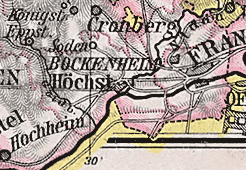District Höchst
| Basic data | |
|---|---|
| Prussian Province | Hessen-Nassau |
| Administrative district | Wiesbaden |
| County seat | High on the Main |
| Inventory period | 1886-1928 |
| surface | 143.5 km² |
| Residents | 86,129 (1925) |
| Population density | 600 inhabitants / km² (1925) |
| Communities | 21 (1886) 18 (1928) |
| Map (1905) | |

|
|
The Höchst am Main district was a district in the Wiesbaden administrative district of the Prussian province of Hessen-Nassau , located between the city of Frankfurt am Main in the east and the Wiesbaden district in the west. The county seat was Höchst am Main .
history
The district Höchst was formed on April 1, 1886 as part of a regional reform in the province of Hessen-Nassau from the communities of the old office Höchst (except the community Heddernheim ) and the communities Langenhain , Lorsbach and Marxheim of the old office Hochheim . The district area had formed the eastern part of the Mainkreis founded in 1867 .
On July 1, 1917, Sindlingen , Unterliederbach and Zeilsheim were incorporated into the city of Höchst am Main.
The Höchst district was dissolved on April 1, 1928. The city of Höchst am Main and the communities of Griesheim , Nied , Schwanheim and Sossenheim were incorporated into the independent city of Frankfurt am Main . All other communities became part of the newly established Main-Taunus-Kreis . The Frankfurt district of Höchst remained the administrative seat of the Main-Taunus-Kreis until 1987.
Population development
| year | Residents |
|---|---|
| 1900 | 55,493 |
| 1910 | 76,811 |
| 1925 | 86,129 |
District administrators

The district administrators were:
- 1886–1892: August von Trott zu Solz (1855–1938)
- 1892–1894: Wilhelm von Meister (1863–1935)
- 1894–1900: Otto von Steinmeister (1860–1937)
- 1900–1910: Heinrich von Achenbach (1863–1933)
- 1910–1920: Robert Klauser (1867–1951)
- 1921–1926: Josef Zimmermann (1871–1929)
- 1926–1928: Wilhelm Apel (1873–1960)
Communities
The Höchst district originally included 21 cities and municipalities, eight of which became districts of Frankfurt am Main and 13 municipalities were assigned to the Main-Taunus district, which comprises a total of 45 cities and municipalities. The towns and municipalities in the district are listed below:
| former parish | today's parish | today's circle |
|---|---|---|
| Eschborn | Eschborn | Main-Taunus-Kreis |
| Griesheim | Frankfurt am Main | Frankfurt am Main |
| Hattersheim | Hattersheim am Main | Main-Taunus-Kreis |
| Höchst am Main , city | Frankfurt am Main | Frankfurt am Main |
| Hofheim am Taunus | Hofheim am Taunus | Main-Taunus-Kreis |
| Kriftel | Kriftel | Main-Taunus-Kreis |
| Langenhain | Hofheim am Taunus | Main-Taunus-Kreis |
| Lorsbach | Hofheim am Taunus | Main-Taunus-Kreis |
| Marxheim | Hofheim am Taunus | Main-Taunus-Kreis |
| Muenster | Kelkheim | Main-Taunus-Kreis |
| Nied | Frankfurt am Main | Frankfurt am Main |
| Niederhofheim | Liederbach am Taunus | Main-Taunus-Kreis |
| Oberliederbach | Liederbach am Taunus | Main-Taunus-Kreis |
| Okriftel | Hattersheim am Main | Main-Taunus-Kreis |
| Schwanheim | Frankfurt am Main | Frankfurt am Main |
| Sindlingen ( 1917 to Höchst ) | Frankfurt am Main | Frankfurt am Main |
| Soden am Taunus | Bad Soden am Taunus | Main-Taunus-Kreis |
| Sossenheim | Frankfurt am Main | Frankfurt am Main |
| Sulzbach | Sulzbach | Main-Taunus-Kreis |
| Unterliederbach ( 1917 to Höchst ) | Frankfurt am Main | Frankfurt am Main |
| Zeilsheim ( 1917 to Höchst ) | Frankfurt am Main | Frankfurt am Main |
Web links
- District Höchst administrative history and the district administrators on the website territorial.de (Rolf Jehke), as of April 14, 2014.
Individual evidence
- ^ A b Register of municipalities in Germany 1900: Landkreis Höchst
- ^ A b Michael Rademacher: German administrative history from the unification of the empire in 1871 to the reunification in 1990. District Höchst. (Online material for the dissertation, Osnabrück 2006).
- ↑ District order for the province of Hessen-Nassau 1886 (digitized version)
- ^ "Sindlingen, City of Frankfurt am Main". Historical local dictionary for Hessen. (As of November 11, 2014). In: Landesgeschichtliches Informationssystem Hessen (LAGIS).

